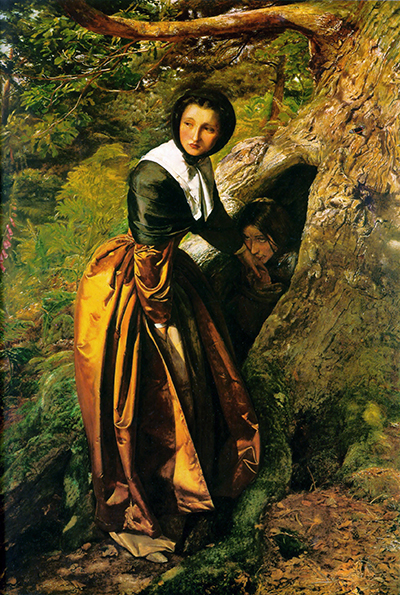The Proscribed Royalist by John Everett Millais is a piece of art whose main aim was not so apparent until it found itself in galleries.
The painting is a clear depiction of humanity; it features a young woman protecting a fleeing young civilian hiding himself in a hollow tree. The Battle of Worcester in 1961 saw the Royalists defeated in the English Civil war, resulting in several deaths and Royalists survivors finding solace in other safe places. In Millais work of ‘an extended helping hand,' the young Puritan woman is seen standing at the base of the tree, looking anxiously in a forest with one hand tucked inside her pocket with the escapee kissing her other hand as a sign of gratitude.
Millais got his painting inspiration from a similar incident that happened to the King of England, Scotland, and Ireland; Charles II, in a scenario wherein a bid to escape from his pursuers hid in a tree. He (Millais) then painted it from an oak tree which came to be famously referred to as the Millais Oak. The printed canvas artwork was then stretched over a wooden frame ready for hanging. The original form of the Proscribed Royalist portrait was in the form of oil on canvas in a wooded scene way back in 1852. Honoring its first exhibition at the Royal Academy of Arts in London, in 1853: ‘The Proscribed Royalist, 1651' the painting currently remains in Lord Lloyd-Webber's collection. Though its net worth has not been arrived at yet, it remains as one of the most historic paintings in England.
Shakespeare's works got the English native painter motivated and prompted him to work more on related storyboards. Poems, opera works, and the critics of his work too made him paint more for survival. John Everett’s use of attention to the storytelling effects in all his portraits has made it possible for all his paintings to find a place in national museums. Everett Millais' artworks have always depicted that great focus on detail and the natural beauty with greater levels in complexity in the images' natural elements. Works of art have ways of narrating incidents in more cryptic, sarcastic, educational or motivational ways. They depict a norm of the society usually in printed or drawn manner with their symbolic elaborative means of telling more than can be said using words.




